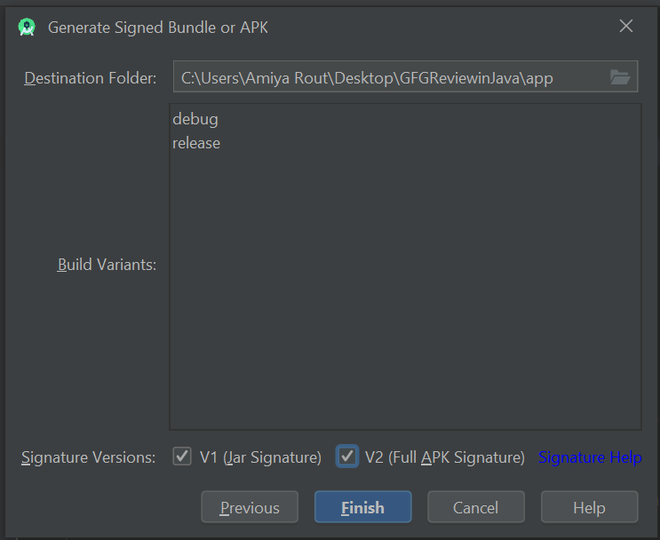
- #Android studio build apk how to
- #Android studio build apk apk
- #Android studio build apk install
- #Android studio build apk full
- #Android studio build apk android
The last chapter was the first step in making a more robust app. If you’ve gotten this far, I assume you care for your users.
#Android studio build apk how to
In the first section of this book, you learned how to release an app with the basics. But it would surprise you how many companies release apps with the default settings because of the time contraints most teams are under.
You can implement optimizations on your code and app to make it run better and occupy less space in your users’ smartphones.Īt this point, you may be thinking the obvious best option is the second one. You can launch it exactly as it was when you, or one of the developers in your team, typed the last line of code. You have two options when releasing an app to your users: 9.2 Implementing build types in your app. #Android studio build apk android
9.1 Switching build types in Android Studio. Locked Build Variants: Implementing Build Types. 7.11 Going one step further in optimization. 7.10 Size reductions to make directly in your code. 7.5 Other improvements you can do with the analysis. 7.3 Best practices for reducing your app size. #Android studio build apk apk
Locked Optimizing App Size & Obfusticating the APK. 6.3 Securing the Organized Simple Note app. 5.6 Simplifying multiple permission requests with Android Jetpack. 5.4 Updating Podplay to search by location. Section II: Security & Optimization Section 2: 6 chapters Show chapters Hide chapters Locked Preparing for Release: Test Tracks. 2.6 Creating your Google Play Store listing. 1.3 In an ideal world, what would “the perfect build” look like?. 1.1 What to expect from the release process. Roland Wales on ASP.Section I: App Store Quick Start Section 1: 4 chapters Show chapters Hide chapters. Reid on C#: Should we still use #region blocks?. shailesh dhapa on 8 Budget Branding Strategies for a Small Business. Frank on Here's why you should NOT buy a Sabrent Rocket SSD. Riyaz on RunningLow - PowerShell script to check for disk space and send e-mail. tim on Here's why you should NOT buy a Sabrent Rocket SSD. Alexander on ASP.NET C# - System.IO.IOException: process can't access the file because it is being used by another process in File.ReadAllBytes - How to fix it. André on Linux - Resize-Extend a disk partition with unallocated space (CentOS, Ubuntu, VM).  Mehran Hoodeh on Office Interop DCOM Config on a Windows Server IIS Machine to open Word, Excel and Access files with ASP.NET C#. Mark on MS Office - Error 0xc0000142 on Excel and Word - Fix. Rayne Bair on HTTP Error 500.30 - ASP.NET Core app failed to start - Solution. Tauta on Mantis BT CustomContent plugin - add custom PHP, HTML, CSS and JS files in Mantis HTML Layout. The fix for such scenario is to apply both of these signatures, by selecting the two checkboxes - just like shown in the following screenshot: As you might easily guess,older phones with older android versions don't support the new v2 signature versions, hence they will raise the "app not installed" error if the APK only contains that one.
Mehran Hoodeh on Office Interop DCOM Config on a Windows Server IIS Machine to open Word, Excel and Access files with ASP.NET C#. Mark on MS Office - Error 0xc0000142 on Excel and Word - Fix. Rayne Bair on HTTP Error 500.30 - ASP.NET Core app failed to start - Solution. Tauta on Mantis BT CustomContent plugin - add custom PHP, HTML, CSS and JS files in Mantis HTML Layout. The fix for such scenario is to apply both of these signatures, by selecting the two checkboxes - just like shown in the following screenshot: As you might easily guess,older phones with older android versions don't support the new v2 signature versions, hence they will raise the "app not installed" error if the APK only contains that one. 
#Android studio build apk full
By default, Android Studio 2.2 and the Android Plugin for Gradle 2.2 sign your app using both APK Signature Scheme v2 and the traditional signing scheme, which uses JAR signing - meaning that they give the option to sign the APK with either a JAR signature (aka v1) or a full APK sign (aka v2): to be more specific, during the process of building the app the developer is asked to choose between using one or these signature version, none or both of them.
#Android studio build apk install
As you can read here, Android 7.0 "Nougat" introduced the APK Signature Scheme v2, a new app-signing scheme that offers faster app install times and more protection against unauthorized alterations to APK files. This workaround should be the first thing to try if you're using older phones and/or Android builds <= 6.

Unsupported v2 Signature (aka Full-APK Signature) Here's a couple solutions I've come with, mostly thanks to the following StackOverflow thread. APK and/or uninstalling the app's previous version (if any) seems to fix the issue. It also goes without saying that neither rebooting the phone and/ or removing the existing. That's not the best documented error you can hope for, isnt'it? What makes things ever worse is the fact that the APK is most likely working on other devices, including the Android emulator you (or the developer) just tested it with. Are you an Android developer or tester? Do you often play with APK files coming from "insecure sources" such as signed APKs built with Android Studio? In case you do, you might likely experience the following problem when trying to install those apps:







 0 kommentar(er)
0 kommentar(er)
